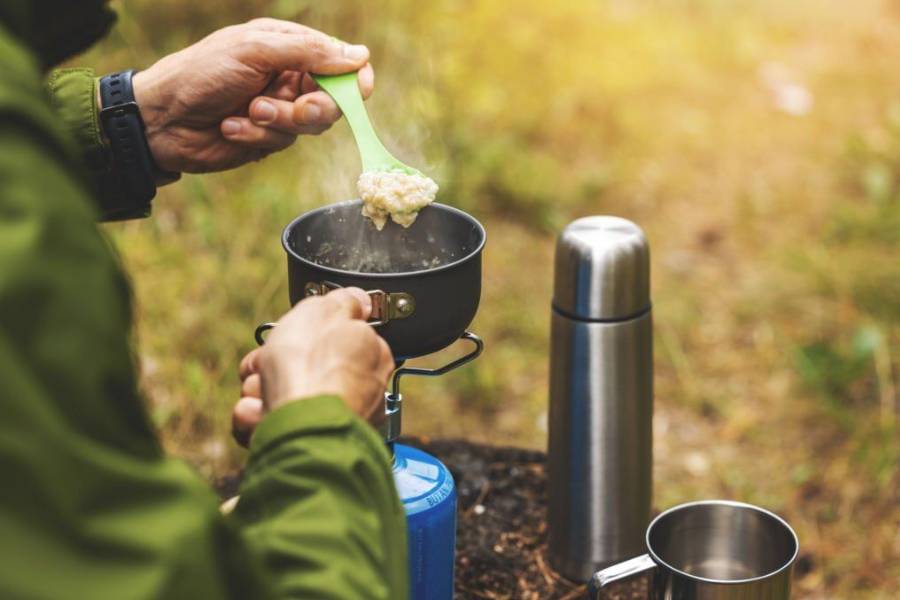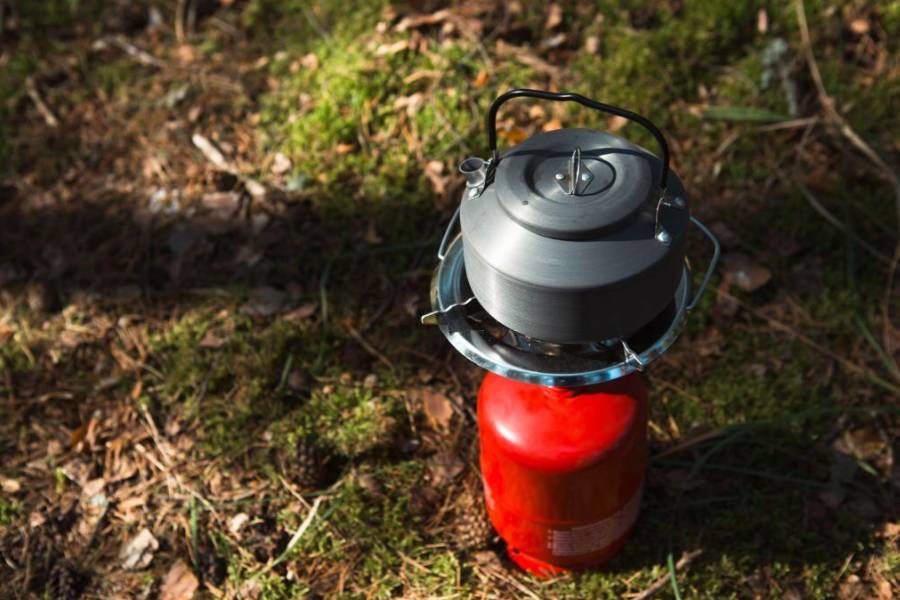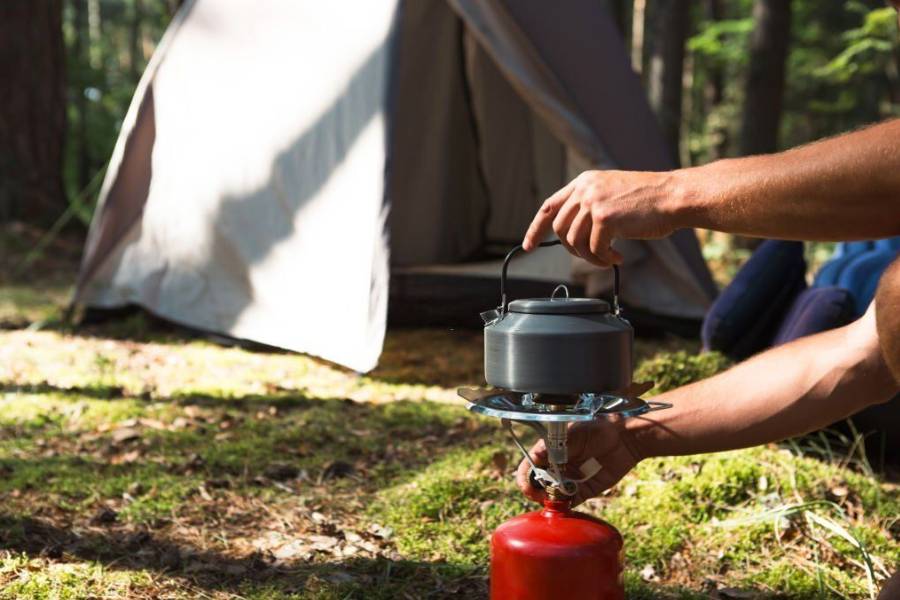
Camping is a popular outdoor activity that provides an escape from city life and allows campers to connect with nature. An essential aspect of the camping experience is preparing meals, and for many campers, a reliable camping stove is a valuable companion.
In today’s article, we’ll explain how to use a camping stove optimally and safely. Whether you’re a seasoned hiker or occasional camper, using the stove correctly is essential to fully enjoy your outdoor meals.
How to Use a Camping Stove
Let’s see how to use a camping stove in our complete step-by-step guide…
Choosing the Right Type of Camping Stove
Before knowing how to use your camping stove, you must first choose the right model according to your needs. There are several types of camping stoves on the market:
- Gas Stove: Camping gas stove works with a bottle of butane or propane gas. It’s the most common choice for campers because it offers good value and ease of use.
- Fuel or Alcohol Stove: Uses a liquid fuel such as white gasoline or alcohol. This type of stove is often preferred by hikers because of its lightness and its performance even at altitude.
- Wood Stove: Burns small pieces of wood or pellets. Ideal for environmentally conscious campers, this stove does not require a gas bottle and produces a beautiful flame.
There are different points to take into account such as ease of lighting, cooking time, lightness, and compatibility with different types of cookware to make the right choice.
Setting Up Your Camping Stove Safely
After choosing the right camping stove, you need to set up your stove properly. It is very important to have a safe installation of your camping stove. Here are various tips to follow for optimal use.

Find a Stable, Level Surface
As a first step, we advise you to find a stable and flat surface. Gas stoves are generally equipped with removable feet to ensure better stability on different surfaces such as the ground, a table, or a stone. Nevertheless, make sure that the device is well anchored to the ground. In addition, it is essential that it cannot tip over during use.
Maintain a Safe Distance
When setting up your stove, be sure to maintain a safe distance from flammable items such as tents, clothing, or trees. As a general rule, a distance of at least 1 meter is recommended around the stove. It is also best to use a fireproof surface as a base to avoid any risk of fire.
Protect Your Stove From the Wind
Wind can make it difficult to light the stove and prolong the cooking time. Use a windscreen to protect the flame and increase heating efficiency. Some stove models incorporate a windshield, otherwise, you can make one out of aluminum or buy a suitable accessory.
How to Light and Regulate a Camping Stove?
The ignition and adjustment of a gas stove are very important points to ensure a good user experience. Here are different ways to light a stove depending on the type of fuel used.

Light a Gas Stove
To light a gas stove, it is necessary to follow different steps in a specific order. Here is what we recommend:
- Connect the Gas Cylinder: Begin by screwing the gas cylinder onto the regulator of the camping stove. Ensure a secure and tight connection to prevent gas leaks.
- Open the Gas Valve: Gently turn the knob on the gas valve to open it. Be cautious not to turn it too quickly to avoid sudden surges of gas.
- Ignite the Stove: If your stove features an integrated ignition system, press the ignition button to create a spark and ignite the flame. Alternatively, use a lighter or fire starter to carefully light the stove.
- Adjust the Flame: Once the flame is lit, adjust the size accordingly by turning the valve. Turning it clockwise usually reduces the gas flow, while turning it counterclockwise increases it. Find the optimal flame size for your cooking needs.
Light a Gasoline or Fuel Stove
The operation of the gasoline stove is slightly different. It will therefore be necessary to take some additional precautions:
- Fill the Tank: Start by filling the stove’s tank with the appropriate fuel, which can be white gasoline or alcohol. Ensure you use the recommended fuel for your specific stove model.
- Prime the Burner: Open the valve slightly to let a small amount of fuel flow out. This process is known as priming the burner and helps establish the initial fuel presence in the system.
- Close the Valve: Once the burner is primed, close the valve to stop the flow of fuel. This prevents excessive fuel buildup and enhances safety during ignition.
- Ignite the Primer: Ignite the fuel that has collected in the primer or pre-heating chamber. This is usually a small, designated area where the initial combustion occurs to establish a stable flame.
- Wait for Stable Flames: Allow some time for the flames to become stable. This ensures that the stove is ready for cooking and that the fuel is burning consistently.
- Adjust the Flame: Open the valve to adjust the size of the flame according to your cooking needs. Turning the valve clockwise usually reduces the fuel flow, while turning it counterclockwise increases it.
Light a Wood Stove
Finally, the wood stove lights easily if you have a little experience:
- Choose the Right Fuel: Select suitable fuel for your wood stove, such as wood pieces, pellets, or twigs. Ensure the wood is dry to facilitate easier ignition.
- Load the Combustion Chamber: Place the chosen fuel in the combustion chamber of the wood stove. Add dry kindling, paper, or straw as fast-burning igniters. Ensure proper ventilation by arranging the fuel for optimal airflow.
- Ignite the Fire: Use a lighter or match to ignite the paper, kindling, or straw. Ensure that the fire catches and starts to spread to the rest of the fuel.
- Add Wood or Fuel as Needed: Once the fire is established, add wood or additional fuel regularly to maintain a steady flame. Keep in mind that adding smaller pieces may help control the intensity of the fire.
- Adjust Airflow: Most wood stoves come with adjustable vents or dampers. Control the airflow by adjusting these vents to regulate the intensity of the fire. More air generally means a hotter and faster-burning fire.
- Monitor and Maintain: Keep a watchful eye on the wood stove while cooking. Adjust the fuel as needed to maintain the desired heat level for your culinary endeavors.
Tips for Cooking Efficiently With a Camping Stove
Finally, here are some practical tips for cooking well with your camping stove:
- Prepare Ingredients in Advance: Save time and fuel by prepping ingredients before lighting the stove. Cut vegetables, defrost meat, and organize spices, making the cooking process smoother.
- Use Suitable Cooking Utensils: Opt for camping-specific cooking pots and utensils that are lightweight and heat-resistant. Choose sizes appropriate for the number of people you’re cooking for.
- Cover Food While Cooking: Speed up cooking and reduce fuel consumption by covering the cooking pot with a lid. This helps trap heat and cook food more efficiently.
- Watch Cooking Closely: Camping stoves heat up quickly, so keep a close eye on your cooking. Prevent burning or sticking by monitoring the process and adjusting the heat as needed.
- Clean Grates and Burners: After each use, clean the grates and burners to prevent grease and residue buildup. A clean stove operates more efficiently and ensures a better cooking experience.
- Check Seals and Valves: Regularly inspect the seals and valves of your camping stove to ensure they are in good condition. This helps maintain optimal and safe stove operation. Replace any worn-out parts promptly.
Conclusion
By following these tips and mastering the use of your camping stove, you are now ready to fully enjoy your outdoor meals and your adventures with complete peace of mind! Remember to choose a brand known for the quality of its stoves. Compare features and prices, and read reviews from other buyers before choosing your stove. With a little research and planning, you can find the perfect gas stove for your next outdoor camping adventure.
See Also…